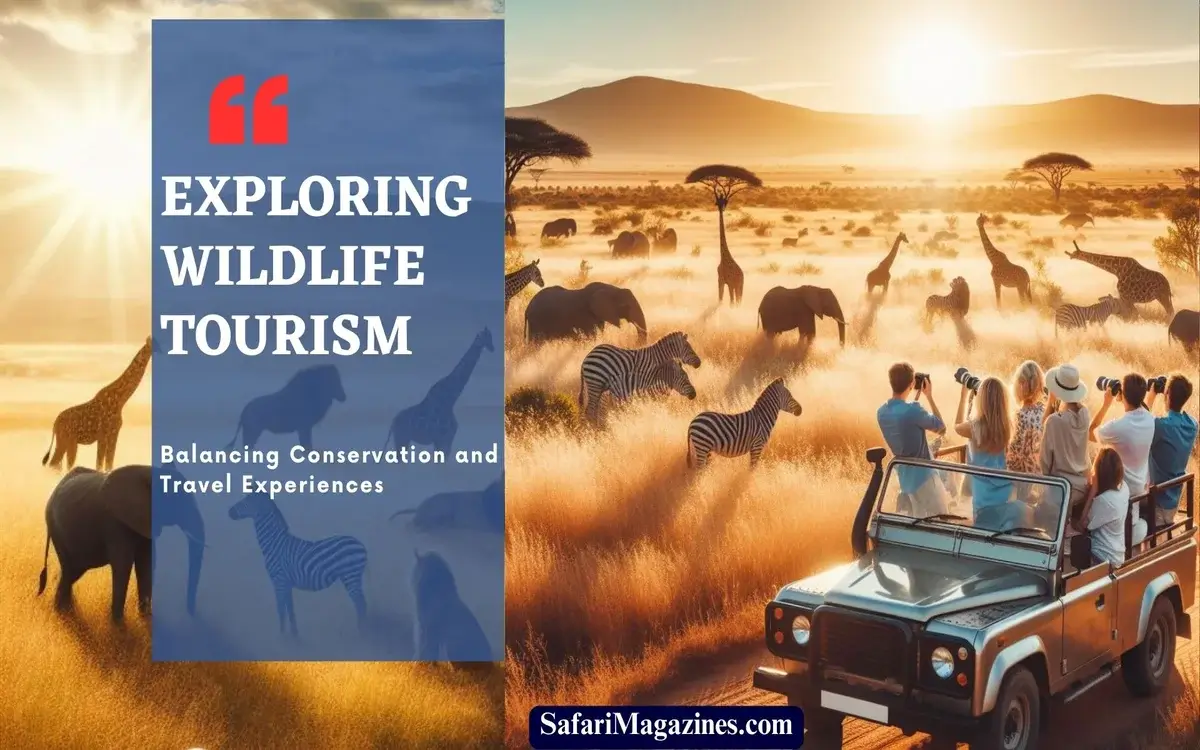
Wildlife Tourism. Balancing Conservation and Travel Experiences. Wildlife Tourism offers a unique opportunity for travelers to immerse themselves in the natural world, experiencing the beauty and diversity of animal life in their natural habitats. This form of tourism has gained popularity in recent years, driven by a growing interest in environmental conservation and sustainable travel practices.
Table of Contents
ToggleThe Appeal of Wildlife Tourism
One of the main draws of wildlife tourism is the chance to connect with nature on a deeper level. Unlike traditional tourist attractions, wildlife encounters offer a sense of wonder and awe. So, it’s allowing visitors to witness animals in their natural habitats. From majestic lions roaming the African savannah to playful dolphins in the ocean, these experiences create lasting memories and foster a sense of appreciation for the natural world.
Ethical Considerations in Wildlife Tourism
However, with the rise in popularity of wildlife tourism comes a need for greater awareness of the ethical considerations involved. Many popular tourist destinations are home to endangered species, and irresponsible tourism practices can have a detrimental impact on their habitats. It’s essential for travelers to choose tour operators that prioritize conservation and follow responsible tourism guidelines to minimize their environmental footprint.
Continue reading: Exploring Wildlife Tourism: Balancing Conservation and Travel Experiences
Popular Wildlife Tourism Destinations
Some of the world’s most iconic wildlife tourism destinations include African safaris, where visitors can witness the Big Five in their natural habitat. Also the Galapagos Islands, known for their unique biodiversity. And the lush rainforests of Costa Rica, home to a staggering array of plant and animal species.
Types of Wildlife Tourism Activities
Wildlife tourism offers a diverse range of activities for travelers to enjoy. From exhilarating safari tours through the African bush to serene birdwatching expeditions in remote forests, there’s something for everyone to experience. For those drawn to the ocean, whale watching cruises provide an opportunity to observe these majestic creatures up close in their natural habitat.
Challenges Facing Wildlife Tourism
Wildlife tourism faces significant challenges that need to be addressed for its long-term sustainability. The main issue is the threat to endangered species and their habitats due to increasing numbers of tourists. This puts pressure on ecosystems, leading to habitat degradation, pollution, and disturbances to wildlife.
Benefits of Wildlife Tourism
Despite these challenges, wildlife tourism also brings significant benefits to local communities and conservation efforts. The revenue generated from tourism helps fund conservation projects and supports local economies, providing an incentive for communities to protect their natural resources. Additionally, wildlife tourism plays a crucial role in raising awareness about environmental issues and advocating for wildlife conservation on a global scale.
Continue reading: Exploring Wildlife Tourism: Balancing Conservation and Travel Experiences
Tips for Responsible Wildlife Tourism: Embracing Sustainable Adventure
To ensure that your wildlife tourism experience is both enjoyable and ethical, it’s essential to follow some basic guidelines. Choose tour operators that prioritize conservation and sustainable practices, and avoid activities that involve captive or exploited animals. Respect wildlife habitats and observe animals from a safe distance, refraining from feeding or approaching them.
1. Choose Certified Tour Operators
When planning your wildlife tourism adventures, opt for tour operators that are certified by recognized organizations like the International Ecotourism Society (TIES) or the Global Sustainable Tourism Council (GSTC). These certifications ensure that the operator adheres to strict sustainability standards and prioritizes conservation efforts in their operations.
2. Minimize Single-Use Plastics
Single-use plastics pose a significant threat to marine life and terrestrial ecosystems. When embarking on wildlife tourism excursions, bring reusable water bottles, bags, and utensils to minimize plastic waste. Additionally, support accommodations and tour operators that have implemented plastic reduction initiatives.
3. Respect Wildlife and Their Habitat
While encountering wildlife in their natural habitat is undoubtedly exhilarating. It’s essential to observe them from a respectful distance and avoid disturbing their behavior. Avoiding feeding wild animals, touching coral reefs, or venturing off their designated paths. Because actions like these can have bad effects on the well-being of wildlife.
4. Support Local Conservation Efforts
Before booking wildlife tourism experiences, research the destination’s conservation projects and initiatives. Choose operators that actively contribute to local conservation efforts through donations, community engagement, or wildlife rehabilitation programs. By supporting these initiatives, you directly contribute to the preservation of biodiversity and the protection of endangered species.
5. Educate Yourself and Others
Knowledge is a powerful tool in promoting responsible wildlife tourism practices. Take the time to educate yourself about the ecosystems, species, and conservation challenges of the destinations you visit. Share your knowledge with fellow travelers and advocate for sustainable travel practices within your community.
6. Offset Your Carbon Footprint
Traveling to wildlife tourism destinations often involves air or road transportation, which contributes to carbon emissions. Consider offsetting your carbon footprint by participating in carbon offset programs or supporting reforestation projects. Many organizations offer carbon calculators that allow you to estimate and offset your emissions from travel.
7. Respect Cultural Heritage
In addition to respecting natural habitats, it’s crucial to respect the cultural heritage of local communities when engaging in wildlife tourism activities. Learn about the traditions, customs, and beliefs of indigenous peoples and other local communities, and seek permission before entering sacred sites or participating in cultural ceremonies.
Continue reading: Exploring Wildlife Tourism: Balancing Conservation and Travel Experiences
The Future of Wildlife Tourism
As we look to the future, the importance of sustainable wildlife tourism cannot be overstated. By adopting innovative technologies and practices, such as eco-friendly transportation and low-impact accommodations, we can minimize our environmental footprint while still enjoying the wonders of the natural world. Community involvement and collaboration will also be key to ensuring the long-term viability of wildlife tourism, empowering local communities to benefit from and protect their natural heritage.
Final Thoughts: Preserving the Beauty of Our Planet
As we venture into the wilderness in search of adventure and discovery, let us remember that we are but guests in the homes of the creatures that inhabit these landscapes. By embracing responsible wildlife tourism practices, we can ensure that future generations will have the opportunity to marvel at the wonders of the natural world. Let us tread lightly, leave no trace, and leave behind a legacy of conservation and stewardship for the generations to come.
Related topics:
- Beneath the Waves: Marine Conservation Tourism
- Adventure Tourism: Thrilling the Uncharted Path of Exploration
- Discover the Largest National Parks in Europe: Exploring Nature and Wild Landscapes
- Cultural Tourism Examples, Destinations and Activities
Custom Message
Wildlife tourism offers a unique opportunity to experience the beauty and diversity of the natural world while supporting conservation efforts and local communities. By choosing responsible tourism practices and advocating for wildlife conservation, travelers can help ensure that future generations will continue to enjoy the wonders of our planet’s wildlife.
FAQs
Q1: Is wildlife tourism safe?
A1: While wildlife tourism can be safe when conducted responsibly, it’s essential to follow guidelines and respect wildlife habitats to minimize risks to both travelers and animals.
Q2: How can I choose a responsible wildlife tour operator?
A2: Look for tour operators that prioritize conservation, have a strong commitment to ethical practices, and support local communities.
Q3: What should I do if I encounter a wild animal during a wildlife tour?
A3: Maintain a safe distance, avoid sudden movements or loud noises, and follow the guidance of your tour guide to ensure the safety of both yourself and the animal.
Q4: How does wildlife tourism contribute to conservation efforts?
A4: Revenue generated from tourism helps fund conservation projects, support wildlife sanctuaries, and provide incentives for local communities to protect their natural resources.
Q5: What are some sustainable practices I can adopt as a wildlife tourist?
A5: Choose eco-friendly accommodations, minimize waste, and support conservation initiatives by donating to reputable organizations or volunteering your time.
Useful External Links:
https://www.nationalgeographic.com/travel/article/how-to-do-wildlife-tourism-right
